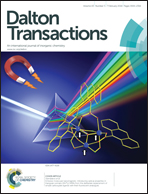Rapid microwave-assisted sol–gel preparation of Pd-substituted LnFeO3 (Ln = Y, La): phase formation and catalytic activity†
Abstract
We present a rapid microwave-assisted sol–gel approach to Pd-substituted LnFeO3 (Ln = Y, La) for applications in C–C coupling reactions. These materials could be prepared in household microwave ovens in less than 15 minutes of reaction time with the final materials displaying well-defined structure and morphology. Phase evolution was studied using time-dependent microwave heatings and then compared with the results obtained from thermogravimetric analyses. Materials were confirmed to be phase pure by laboratory and synchrotron X-ray diffraction. Substituted Pd is ionic as shown by the binding energy shift from X-ray photoelectron spectroscopy. The short heating periods required for phase purity allow these materials less time for sintering as compared to conventional solid state preparation methods, making relatively high surface areas achievable. These materials have been successfully used as catalyst precursor materials for C–C coupling reactions in which the active species is Pd0. Pd-substituted LnFeO3 (Ln = Y, La) provides Pd0 in solution which can be complexed by the ligand SPhos, allowing for aryl chloride coupling.


 Please wait while we load your content...
Please wait while we load your content...